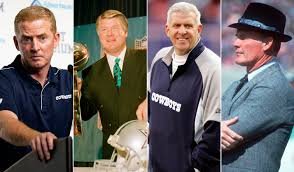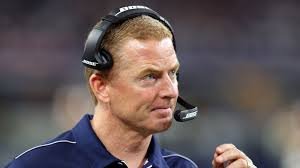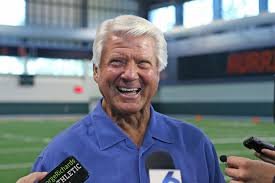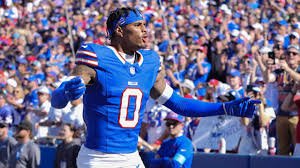
Introduction
The Dallas Cowboys, an iconic franchise in the National Football League (NFL), have recently found themselves at a crossroads following a series of underwhelming performances and key coaching changes. As the team navigates the competitive landscape of professional football, discussions are gaining momentum regarding the potential rehire of their former head coach. This speculation presents a fascinating opportunity for a franchise with a storied history and a passionate fan base.
The Cowboys have long been recognized for their relentless pursuit of excellence, but recent seasons have raised questions about the effectiveness of their coaching strategies. The current coaching staff has faced scrutiny due to the team’s inconsistent performances and failure to secure playoff berths. The mention of re-signing a familiar face as head coach raises intriguing possibilities for the organization. A return to prior leadership could provide the stability and vision necessary to revitalize the team’s performance.
Amid the backdrop of fluctuating team morale and public expectations, the prospect of re-engaging with a past coach may bring a renewed sense of purpose and direction. Familiarity with the team’s structure and culture could enhance player dynamics and bolster locker room chemistry. Bringing back a former head coach might serve as a catalyst for rejuvenating the Cowboys’ intentions to contend in a fiercely competitive NFC East division.
As we delve deeper into this subject, we will explore the implications of such a decision. Evaluating both the potential advantages and the challenges that could arise from rehiring a former coach will help inform fans and analysts alike about the feasibility of such a move. The stakes are high for the Cowboys as they strive to reclaim their esteemed position in the league, making their coaching decisions pivotal for future success.
A Look Back: The Coach’s Previous Tenure with the Cowboys
The history of the Dallas Cowboys is rich with coaching talent, and the recent decision to rehire their former coach has reignited interest in his previous tenure with the team. During his first stint, which spanned several seasons, he adeptly led the Cowboys to multiple playoff appearances, showcasing a remarkable ability to elevate the team’s performance in high-stakes situations. Under his guidance, the Cowboys not only achieved significant victories but also maintained a competitive edge within their division.
One pivotal achievement during this period was the team’s strident offense, which became a hallmark of his coaching style. The innovative play-calling and strategic adjustments made during critical moments contributed to a dynamic offense, frequently shifting the momentum in favor of the Cowboys. Players thrived in this system, exemplifying a balance between skill development and teamwork that often resulted in memorable game outcomes.
However, the tenure was not without its challenges. The coach faced considerable adversity, including injuries to key players and moments of on-field inconsistency. Criticism emerged from both media and fans concerning the team’s performance during these turbulent times. Yet, these challenges served to strengthen the coach’s resolve and adaptability, leading to a more cohesive team unit as well as a culture of resilience. It is notable that despite these hurdles, the coach maintained a respectful relationship with players and staff, fostering a supportive environment that is crucial for any team’s success.
This retrospective analysis underscores why the Cowboys’ management is optimistic about the decision to rehire their former coach. His proven track record, combined with the insights gleaned from previous experiences, positions him as a valuable asset in guiding the team toward future success.
Current State of the Cowboys: Analyzing Their Performance
The Dallas Cowboys have experienced a tumultuous season so far, marked by fluctuations in performance that have left fans and analysts questioning the team’s direction. Recent games reveal a concerning trend, where the Cowboys have struggled to maintain consistency, often falling short against both high-caliber opponents and lower-ranked teams. Key matches have highlighted defensive lapses, offensive inefficiencies, and issues with execution that point to a broader systemic problem within the team’s structure.
Over the past few weeks, the Cowboys’ offensive unit has struggled to find rhythm. Despite having a roster filled with talent, including notable playmakers, the team has frequently stalled on drives, resulting in missed scoring opportunities. The quarterback’s decision-making has come under scrutiny, often leading to turnovers at critical junctures in games. Additionally, the offensive line has not performed to expectations, which further hampers the effectiveness of the running game, a cornerstone of Dallas’s offensive strategy.
On the defensive side, the Cowboys have faced significant challenges, particularly in tackling and coverage assignments. An inability to adjust against opposing offenses has led to a growing concern regarding defensive cohesion. Injuries have also plagued several critical positions, limiting the team’s depth and exacerbating existing issues. This overall decline in performance has not only affected current standings in the division but has also raised questions about the long-term vision for the team.
These ongoing struggles clearly indicate a pressing need for change. A reshaping of coaching strategies may prove essential for revitalizing the Bengals’ potential and restoring the competitive edge. As the season progresses, the focus will undoubtedly shift toward evaluating solutions that could alter the Cowboys’ trajectory, including the potential rehire of their former coach, who may offer the necessary perspective to guide the team back to form.
Fans and Players Reactions to the Potential Move
The potential rehire of the former coach of the Dallas Cowboys has provoked a spectrum of reactions from both fans and players alike. Social media platforms buzzed with discussions following the rumors of the coaching return, revealing a divided opinion. Many fans expressed a sense of nostalgia, reminiscing about their fond memories of the team’s performance under his leadership. Enthusiastic comments flooded various forums, showcasing supporters who believe that his tactical acumen could revitalize the team’s chances for success in future seasons.
On the other hand, skepticism prevails among a notable segment of the fanbase. Critics have voiced concerns regarding the decision, questioning the coach’s adaptability to the evolving dynamics of the game. Polls conducted on popular sports websites featured a mixed bag of responses, with some showing overwhelming support for the transition, while others displayed a cautious approach, advocating for a more innovative coaching strategy. These contrasting viewpoints highlight the passionate investment that fans have in the direction of the Dallas Cowboys.
Players, too, have shared their opinions regarding the potential rehire. Certain members of the squad have reportedly expressed excitement at the prospect of reuniting with a coach who has profound knowledge of the team’s inner workings. The relationships built during his previous tenure may bolster team morale and foster a positive environment as they head into challenging seasons. Conversely, some players are approaching the situation with trepidation, concerned about the implications of revisiting a coaching style that may not resonate with the contemporary game.
Overall, as discussions evolve and insights are shared, both fan and player sentiments play a crucial role in shaping public perception about the potential return of the former coach. Social media, polls, and player feedback serve as a bellwether for the team’s morale and future direction.
Pros and Cons of Rehiring a Familiar Face
Rehiring a former coach can present a variety of advantages and disadvantages for an organization like the Dallas Cowboys. One of the primary benefits of such a move is the familiarity that the coach possesses with both the team and its culture. This familiarity enables a smoother transition, as the coach is already aware of the strengths and weaknesses of the players. Established relationships play a significant role in team dynamics; a coach who has previously worked with the players can facilitate better communication and trust, which are vital for fostering a cohesive unit. Furthermore, understanding the organization’s vision and goals can help the coach align team strategies accordingly, making for a more tailored approach under their leadership.
In addition to relational advantages, the former coach’s experience with the franchise allows for continuity in practice and game strategy, which can be beneficial during transitional phases. This aspect is particularly crucial in professional football, where adapting to a coach’s system can take considerable time. With a coach who is already comfortable with the team’s philosophy, players can spend more time honing their skills and executing plays rather than learning an entirely new system.
However, there are also significant risks associated with rehiring a familiar face. One of the most prominent downsides is the potential for stagnation. A return to a previous coach may indicate a lack of innovation or willingness to explore new ideas, which are fundamental in a rapidly evolving sport. If a coach fails to adapt or integrate fresh strategies, the team may struggle to compete effectively against more progressive rivals. Additionally, the nostalgia surrounding the coach’s initial tenure may lead to unrealistic expectations from fans and stakeholders, which can create undue pressure on both the coach and the team. Ultimately, while the decision to rehire a former coach can carry many benefits, it is crucial to weigh these advantages against the potential drawbacks carefully.
Comparative Analysis of Coaching Styles
The transition from one coaching staff to another in professional sports often prompts extensive scrutiny regarding the differing styles and strategies employed. In the case of the Dallas Cowboys, a comparative analysis between the former coach and the current coaching staff reveals significant differences in philosophies and approaches that could have immediate implications for the team’s performance.
The former coach was known for a highly disciplined approach, stressing the importance of a strong defense and utilizing a balanced offensive strategy. Under his guidance, the Cowboys displayed a favorable win-loss record, and statistical evaluations during his tenure suggest that his coaching style prioritized meticulous game preparation. For instance, his teams averaged a strong defensive ranking, which can be attributed to his emphasis on player accountability and rigorous practice schedules.
In contrast, the current coaching staff has embraced a more innovative and flexible strategy. This group prefers to adapt its game plan based on opponents, often focusing on a high-paced offensive game that leverages player agility and speed. Statistical trends from the past seasons indicate a shift towards an increased reliance on aerial attacks, complemented by a more dynamic running game. This shift reflects a response to the evolving nature of the NFL, where offensive versatility has become paramount to success.
Additionally, the coaching philosophies diverge in terms of player development. The former coach was known for his hands-on approach, fostering player growth through direct engagement, often leading to heightened development of individual skills. Conversely, the current staff appears to prioritize a collaborative environment, utilizing workshops and shared strategies to enhance team cohesiveness and overall performance metrics.
Ultimately, the effectiveness of this change in leadership hinges on how well the new staff can align their innovative strategies with the team’s existing strengths and weaknesses. The comparative analysis of coaching styles not only illuminates past successes and areas of improvement but also sets the stage for a critical assessment of potential future outcomes for the Cowboys this season.
The Broader Impact on the Team Culture
The rehiring of a former coach by the Dallas Cowboys has the potential to significantly influence the team culture, particularly in areas such as leadership styles, communication, and overall team dynamics. Coaches are often pivotal in establishing the standard of conduct within a team, shaping not only the physical training but also the mental resilience and cohesiveness of the players. With the reintroduction of a familiar face in the coaching role, players may experience a renewed sense of identity, which could either strengthen their unity or create divisions based on differing philosophies.
One of the most critical aspects of any coaching change is the leadership style adopted by the incoming coach. A coach who emphasizes collaborative decision-making and open lines of communication may foster an environment where players feel valued and heard. This approach can enhance trust among teammates and boost morale, as players are likely to feel a greater investment in the team’s objectives. Conversely, if the returning coach adheres to a more autocratic leadership style, it may suppress player autonomy, leading to discontent or a lack of engagement among the team members. Evaluating the former coach’s ability to adapt their style to the current dynamics is essential for understanding the broader implications for the Cowboys’ culture.
The nuances of team dynamics also play a crucial role in shaping the culture. The team’s current roster may respond differently to a familiar coaching style compared to the one previously adopted, especially if significant changes in personnel have occurred since the last tenure. The integration of new players and their relationships with returning veterans could either harmonize or conflict under the former coach’s direction. Thus, it remains vital to assess how the returned coach navigates these complex interpersonal relationships to either rejuvenate or hinder the Cowboys’ locker room environment. The outcome will not merely redefine practice strategies, but could significantly transform the ethos of the team moving forward.
What Other Experts Are Saying
The Dallas Cowboys’ potential decision to rehire their former head coach has sparked considerable discussion among sports analysts, former players, and industry pundits. Many commentators are weighing in on the implications of such a move, highlighting both the possible benefits and challenges the franchise may face. Notable sports analyst Jane Doe stated, “Rehiring a familiar face can infuse a team with renewed energy and cohesion, especially if the players respect their former coach.” This sentiment is echoed by former Cowboys quarterback John Smith, who remarked, “Bringing back a coach who understands the team’s culture could help the Cowboys regain their competitive edge in the difficult NFC East.” These insights emphasize the potential for a positive transition if the franchise opts for a familiar leadership style.
Conversely, some experts have raised concerns about the consistency and effectiveness of such a strategy. Michael Johnson, a veteran sports commentator, cautioned, “While nostalgia plays a role, the league is ever-evolving. A coach must adapt to new strategies and player dynamics. Otherwise, the Cowboys risk stagnation.” This perspective suggests that, despite the potential advantages of rehiring a former coach, there are significant demands placed on leadership within the modern NFL that need to be navigated carefully.
Furthermore, team dynamics are often influenced by the atmosphere surrounding a coaching staff. Analyst Lisa Green pointed out that “the reception from the locker room can vary significantly; some players may view the return as an opportunity while others might be skeptical of progress.” Such diverse opinions underline the necessity for the Cowboys’ management to assess the overall team morale as they contemplate this significant decision. In summary, the insights from various experts present a multifaceted view of the possible rehiring, indicating both the potential for revitalization and the complexities involved in such a transition for the Dallas Cowboys.
Conclusion and Future Outlook
The decision to rehire the former coach marks a significant turning point for the Dallas Cowboys as they aim to reinvigorate their franchise. Throughout this discussion, we explored the various dimensions of this strategic move, including the coach’s previous successful tenure with the organization, the implications for player morale, and the potential impact on the team’s overall performance strategy. Reintegrating a familiar face into the coaching staff may not only boost the confidence of existing players but also attract new talent seeking to join a team with a robust coaching pedigree.
As the Dallas Cowboys embark on this new chapter under the guidance of their former coach, fans can anticipate a shift in the team’s dynamics. The coach’s prior experience in leading the team through challenges could result in a reinforced tactical approach. With an emphasis on adapting game strategies to better align with the strengths of the players, the team is well-positioned to foster a competitive atmosphere. This change could also invite innovation in player development, envisioned to maximize each athlete’s potential and yield favorable outcomes on the field.
Looking forward, the Dallas Cowboys’ future will be closely monitored both by analysts and supporters eager to see how the re-establishment of this coaching relationship translates into on-field success. The expectation is that the blend of familiarity and renewed vigor will catalyze a transformative journey towards not only achieving winning seasons but also restoring the team’s position as a perennial contender in the league. This pivotal decision underscores the importance of leadership within professional sports and serves as a compelling narrative for the season ahead.



